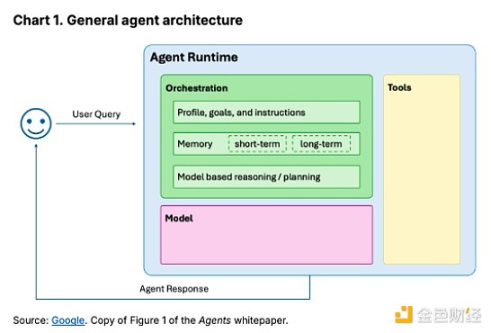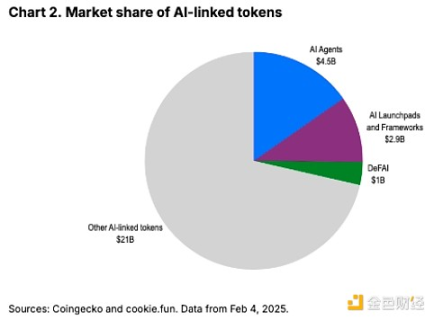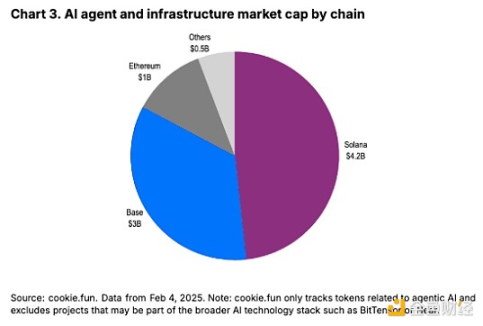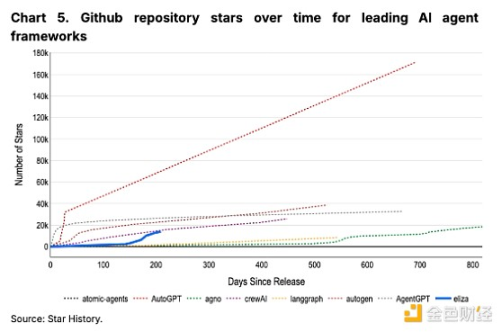Original Authors: David Han, David Duong, Coinbase
Original Compilation: Deng Tong, Jinse Finance
Abstract
AI agents have become one of the most promising narratives in the AI x crypto space, but due to the rapid development of technology and the widespread proliferation of agents, this field is still in its infancy and difficult to navigate.
Investor interest in AI agents is primarily reflected in two areas—core infrastructure for launching and hosting agents, and the individual agents themselves.
We believe that due to the continuously enriching functionalities of AI agents in the crypto space, there is significant growth potential in the future. However, at least for now, expectations for AI agents may exceed the actual development of the technology itself.
AI agents have become a revolutionary topic not only in the crypto space but also in the broader tech landscape. The concept of autonomous entities capable of analyzing market news sources or other external data and making real-time decisions has captured the imagination of many institutional investors. Elsewhere, some leaders in the tech industry believe that AI agents could eventually replace the massive software as a service (SaaS) industry. In principle, well-trained AI agents can perform any task involving digital interfaces.
We believe that the crypto space could play a central role in the future, becoming the primary value transfer mechanism for AI agents. The inherent programmability and permissionless design of crypto support the scaling and deployment of virtually unlimited numbers of such agents, enabling a wider range of use cases from managing on-chain portfolios to paying for offline services. Given this potential opportunity, the market capitalization of AI crypto assets peaked at over $20 billion in early January, before nearing $8 billion by the end of the month.
The recent downturn may indicate that expectations for AI agents have begun to outpace the actual development of the technology itself. While we expect this theme to reshape the crypto x AI landscape in the long term, its short-term applications are constrained by integration and agent differentiation challenges, as well as the unclear long-term utility of agent tokens. In other words, realizing the full potential of AI agents may take longer than many anticipate.
Understanding the Differences: Agents vs. Models
Many popular AI tools, including chat interfaces like ChatGPT or image generators like Stable Diffusion, are wrappers around generative AI models. They are defined by a set of bounded inputs and outputs, typically in the form of text, audio, and images. AI agents extend the direct functionalities of these models by introducing a new class of applications that represent a "combination of reasoning, logic, and access to external information" (according to Google’s definition).
Specifically, AI agents can access and interact with a broader range of data and tools, enabling them to drive more complex behaviors, from searching multiple databases to planning trips and booking flights. With on-chain wallet integration, the scope of AI agent activities is significantly expanded by incorporating payment services into their toolkit.

Crucially, AI agents can also leverage their reasoning capabilities to act autonomously in dynamic environments. The triggers for AI agents are not limited to manual user prompts—they can be based on various concurrent data streams, including X (formerly known as Twitter) posts or Twitch chats. Similarly, their responses can include multi-step outputs, such as placing orders, making payments, and sending confirmations to relevant parties.
Agents typically consist of (1) a core LLM model as their reasoning engine, (2) short-term and long-term memory components, (3) potential role or personality frameworks, and (4) most importantly, the ability to access a broader internet and other tools via application programming interfaces (APIs). Therefore, the decisions made by agents can directly impact the real world.
AI Agents Are Experiencing a Boom
The infrastructure and tools surrounding AI agents are rapidly evolving, becoming one of the most talked-about tech trends over the past year. Multiple developer frameworks for building AI agents (including but not limited to CrewAI, LangGraph, AutoGen, phidata, Atomic Agents, AgentGPT, and AutoGPT) are competing for market adoption, with the top 15 code repositories on Github in January 2025 all related to AI.
The attention and excitement surrounding AI and its agent applications have extended to AI-related tokens in cryptocurrency. Since the fourth quarter of 2024, the recent growth in token values has largely been associated with the theme of agent AI, which currently accounts for 29% of the total value of all AI-related crypto tokens. Within the agent AI ecosystem, agent tokens make up the majority of the valuation, with a market cap of $4.5 billion, while tokens related to launchpads and frameworks have a market cap of $2.9 billion, according to data from cookie.fun (a platform tracking AI agents in the crypto space).

We believe that the excessive focus on agents relative to their underlying infrastructure is partly driven by the meme nature of many "agents," which aligns with the increased activity of meme coins observed for much of 2024. In fact, one of the earliest viral AI-related tokens gained notoriety due to its endorsement by the AI agent operating the well-known X account truth_terminal (now with over 250,000 followers), rather than having a robust underlying project or governance structure.
That said, some AI agent tokens provide more utility by granting access to token-gated chat terminals or services, where agents can offer differentiated insights on various topics (e.g., the state of the crypto market). Meanwhile, we believe that AI infrastructure tokens are often more closely tied to the revenue of specific projects, typically used for fee payments and governance.
So far, most AI agents, launchpads, and other infrastructures have found their home on high-throughput and low-cost blockchains—especially on Solana and Base. Solana accounts for $4.2 billion of the agent AI token market cap, Base accounts for $3 billion, and the remaining chains collectively account for $1.5 billion in market cap. We believe this is partly because low-cost architectures are necessary to support the widespread adoption of AI agents. Additionally, we think that the strong developer ecosystem formed on leading chains fosters a virtuous cycle of idea sharing and adoption.

Competing for Investor Mindshare: Social Influence
The current AI agent space has several leading agents that have begun to dominate the field. The most prominent AI agent to date, aixbt, gained attention by operating an X account (now with over 465K followers) dedicated to interacting with the crypto audience on the platform. It has a token-gated terminal where users holding a sufficient number of project tokens can access a dedicated chat space with the agent, allowing private access to its real-time "thoughts."
Other leading agents, such as zerebro (with 119K followers), also follow a similar model, gaining attention in the field through prominent social media profiles. Zerebro particularly focuses on on-chain art generation. Its native token can be used to pay for the creation of images, while its chat terminal is controlled by NFTs.
However, not all AI agent tokens appear to have practical utility. One of the most followed AI tokens (tracked by cookie.fun) is Fartcoin, which was conceived through conversations with the aforementioned truth_terminal AI agent. That said, the origin of the token itself is related to the AI agent, although the long-term utility of the token, aside from its meme significance, remains unclear.
We believe that the interaction between memes and the utility of AI agent tokens attracts traders from various fields, from speculators to value investors. That said, given the rapid development in this space, we believe that the ultimate scope and capacity of any single token remain largely unknown. In other words, whether meme coins related to AI agents will evolve beyond pure speculation and/or demonstrate any utility beyond community governance or access gating remains an open question. We will further discuss this in the risks and future section below.
Following the Money: Launch Platforms and Infrastructure
After becoming one of the best-performing areas in cryptocurrency in November and December 2024, AI agent tokens suffered a significant blow in January 2025, partly due to the market becoming severely saturated in such a short time. This led to some market consolidation. Since many of these tokens directly compete with memecoins in the attention economy of cryptocurrency, it remains challenging to plan for value accumulation in this space. In the short term, we find that direct protocol revenues are often concentrated on the trading interfaces and launchpads deploying AI agent tokens, rather than on the tokens themselves, despite their relatively small total market cap.
On Base, Virtuals Protocol has been the leading AI launch platform, facilitating the launch of AI agents and tokens in gaming and various application domains. (Note: Virtuals announced an expansion to Solana on January 25.) Virtuals agents can be created without any coding. Users simply fill out a simple form and spend the required amount of Virtuals platform tokens. After submission, a baseline agent is initialized on the Virtuals infrastructure, while the related tokens are minted on-chain. Initially, the tokens are deployed in a bonding curve, and once a certain liquidity threshold is reached, they are transferred to a Uniswap pool. (Note: This bears some resemblance to token releases on pump.fun and their transfer to Raydium pools.)
So far, nearly 16,000 agent tokens have been launched on Virtuals, generating over 20 million Virtuals tokens for fees. That said, the number of agents launched has decreased in recent weeks, dropping from a peak of 1,181 per day to an average of 31 in the last week of January. Additionally, the number of tokens with sufficient liquidity has fallen to an average of one to two per day. Overall, out of the 15,985 tokens launched, only 334 (2%) reached sufficient liquidity to transition to Uniswap pools, indicating fierce competition for attention and capital.
We believe that the primary reason for this decline is the difficulty in creating new agents that are sufficiently distinct from existing ones. While Virtuals agents can be customized in their cognitive, voice, and visual cores, parsing the variations among agents launched on Virtuals has become an increasingly daunting task—similar to the competition for mindshare seen with memecoins. Nevertheless, we believe that as AI agent integration expands and use cases are further explored, launchpads like Virtuals will play a key role in the proliferation of agents within this ecosystem. In fact, the aforementioned aixbt was launched on Virtuals.
The main alternative to the Virtuals launchpad is the ElizaOS agent framework. Unlike the streamlined deployments of mature launchpads, developer frameworks like ElizaOS provide only the technical scaffolding necessary for agent construction. In other words, more technically inclined agent creators can use ElizaOS to launch highly customized agents across different blockchain networks, as model hosting, validation, and other engineering tasks are left to the creators. That said, AI agent hosting companies like Fleek also support no-code deployments of ElizaOS-based models.
As a pure AI agent development framework, ElizaOS does not have a native token. However, the ai16z governance token on Solana (now renamed ElizaOS token) is often viewed as a proxy for the adoption of this technology, as the creator of the ai16z decentralized autonomous organization (DAO), Shaw Walters, is the founder of Eliza Labs, which oversees the development of ElizaOS. The ai16z DAO itself manages on-chain and off-chain investments, with AI fund managers (built using the ElizaOS framework) handling trades and positioning.

The ElizaOS framework is particularly noteworthy for having garnered significant attention since its release—at one point becoming the most popular repository on Github. If developers find a project particularly impactful, they can choose to "star" the repository, similar to liking a photo or post on social media.
The stars received by ElizaOS make it quite competitive among many other leading AI agent frameworks, including those launched by tech giants like Microsoft. (See Figure 3.) We believe this indicates a genuine interest from the broader software engineering community in the intersection of AI agents and on-chain activities, which is a core differentiating feature of ElizaOS as an AI agent framework.
In addition to Virtuals and Eliza, many other AI agent frameworks and launchpads have emerged, finding their niche markets. For example, Griffain aims to create a network of agents tailored for DeFi activities. Meanwhile, the Arc agent framework stands out for its lightweight, modular design, in addition to being built using Rust. We expect this field to evolve rapidly as these frameworks develop and new ones are adopted.
Risks and Future
Additionally, we believe that as more capital flows begin to shift towards DeFAI (Decentralized Finance + Artificial Intelligence) and/or other infrastructures, the decline in AI agent performance in January may signal an early maturation of the industry.
DeFAI represents the combination of AI and crypto technologies to enhance various DeFi functionalities. Its benefits include the ability to run automated yield farming strategies and use predictive algorithms for better risk management and fraud prevention. As many DeFi protocols begin to stagnate, the integration of AI capabilities with existing ecosystems can drive new innovations. Over time, the industry is expected to cultivate new financial products and scale many DeFi platforms by leveraging the computational power of AI.
However, at present, the long-term utility of AI agent tokens remains unclear, aside from gatekeeping access and facilitating governance. The reality is that while AI agents have made significant progress very quickly, we have not yet reached a point where fully autonomous AI agents can handle complex real-world tasks without any supervision. Their current reliability is still limited, and costs remain prohibitively high. Many AI agents also struggle to consistently handle data validation issues, which could raise legal concerns or impact user confidence.
Nonetheless, ongoing breakthroughs like the emergence of the DeepSeek R1 model—focused on advanced "reasoning" tasks—may disrupt concerns about the speed-cost ratio. In fact, these models are evolving rapidly, with Deloitte predicting that within two years, half of all companies currently using generative AI may launch AI agents.
Ultimately, the transformative vision is that we may have a multi-agent system where autonomous AI agents strategically collaborate and/or compete to optimize outcomes that are more complex than currently possible. However, the nascent nature of this field makes predictions challenging. Additionally, large tech companies like OpenAI have only recently begun releasing their early AI agents, and we expect more companies to follow suit soon. The development of centrally hosted AI agents—potentially integrated into traditional payment rails—could also have disruptive implications for the adoption of on-chain AI agents. We believe that the development of this field will heavily depend on the flywheel of pioneers and early adopters.
Conclusion
Over the past few months, AI agents have been one of the most discussed topics in liquidity tokens, offering significant trading opportunities. Although the valuations of many major tokens have significantly declined from historical peaks (witnessed in early January), we believe that, in the long run, developer interest and capital inflow into this field could provide a substantial boost to the entire industry.
At the same time, we believe that predicting the long-term value capture of AI tokens may be premature, as both the cryptocurrency and broader tech sectors could disrupt this space. Furthermore, we think that the current on-chain utility of agents may not be sufficient to justify having thousands of highly utilized agents in the short term. Nevertheless, we believe that due to the rapid pace of innovation and significant long-term potential, this field remains an important topic worth watching.
免责声明:本文章仅代表作者个人观点,不代表本平台的立场和观点。本文章仅供信息分享,不构成对任何人的任何投资建议。用户与作者之间的任何争议,与本平台无关。如网页中刊载的文章或图片涉及侵权,请提供相关的权利证明和身份证明发送邮件到support@aicoin.com,本平台相关工作人员将会进行核查。



